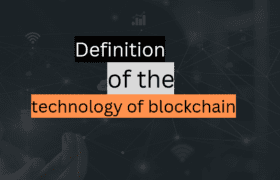Blockchain Technology is a shared ledger that records transactions, build trust, and track assets in a business network. this technology can be used for creating a public or permanent transparent ledger system for compiling data in different industries such as tracking patients in health industry or tracking payment in an online shopping.
Table of Contents
- How does Block Technology Works?
- The Root of the technology.
- The Process of Blockchain Technology
- The Benefits of using Blockchain in Cybersecurity.
- How secure digital identities can be created?
- Blockchain-Powered Secure Digital Identity Systems to Empower Users
- Conclusion
How does Block Technology Works?
This Technology works by the creation of chain of blocks which includes data representing anything that has a value, each of them has a cryptographic hash that belongs to the previous block, a timestamp, and transaction data. These are connected chronologically in an immutable chain. So, the differences between block chain and cryptocurrencies are the technology that enables the cryptocurrencies to function.
The Root of the technology.
The transactions are recorded in blockchain network only once, this runs out the duplication unlike typical traditional business networks. no participant can modify the transaction once it is recorded to the shared ledger. if the transaction has an error, the new transaction has to be added in order to reverse the error, then the both transaction would be visible.
The Process of Blockchain Technology
A smart contract is a set of instructions that is automatically executed and stored on the blockchain to speed up transactions. A clever agreement can set specifications for business bond payments, what amount of travel insurance must be purchased for, and a lot more. The data block can record who, what, when, where, how much, and also the condition, such as the temperature of a food shipment. These blocks form a data chain when ownership changes, or an asset is moved from one location to another. The blocks link securely together to prevent any changes in the block, and they validate the precise timing and order of transactions.
The Benefits of using Blockchain in Cybersecurity.
This technology can be beneficial for cybersecurity, as the significant benefit is that they provide a tamper-proof way to store data, could make an ideal solution to the industry. it has better transactional security than traditional, centralized services for network transaction ledger securely.
Distributed Ledger Technology
in cyberattacks, the centralized databases are the target of adversaries, if they are compromised, the whole comes into that effect. in blockchain, distributed ledger technology is the solution to avoid such cases. it increase security because it creates a situation where there is not a single point of contact. if one of the DLT node is compromised, other nodes will not be effected.Thus, DLT maintains the availability, transparency and continue the transaction
Secured Digitization
This Technology can be used to create a secure digital identities to prevent theft. Blockchain technology can be used to secure data, prevent cyberattacks, and also protect critical or sensitive information.
How secure digital identities can be created?
these identities can be created by providing the interoperable, regular, and tamper-proof infrastructure that has various benefits for organization, users, and Internet of Things (IoT) managed systems. Information for such identity is traceable and can be verified in a matter of seconds. Individuals can control their data sharing, and on the other hand the issuers can easily connect with others to provide instant verification. the infrastructure and security is handled in blockchain-based platform without exposing the data which used to generate credentials, only allowed networks have access, and all processes are permanently transacted as a blockchain technology.
Blockchain-Powered Secure Digital Identity Systems to Empower Users
Blockchain Identity systems enable users to monetize the data owned by them, track the usage, and share it easily and securely. this technology allows the users to crate and manage the identities through three combined components,a; Decentralized identifiers, b; identity management, c; embedded encryption. So, the decentralized identifiers are the new type of it which enables verification. identity management is referring to the process of maintaining, creating, and deleting user identities. Embedded encryption is using encryption algorithms for the protection of the data form unauthorized access,
Conclusion
In conclusion, by offering a consistent, interoperable, and tamper-resistant architecture that has major advantages for businesses, users, and IoT management systems, blockchain technology can be utilized to build secure digital identities. Users are now able to monetize their own data, monitor its usage, and easily share and safeguard it thanks to blockchain identity systems. Digital identities can be made secure and unchangeable with the use of decentralized identifiers, identity management, and embedded encryption.


